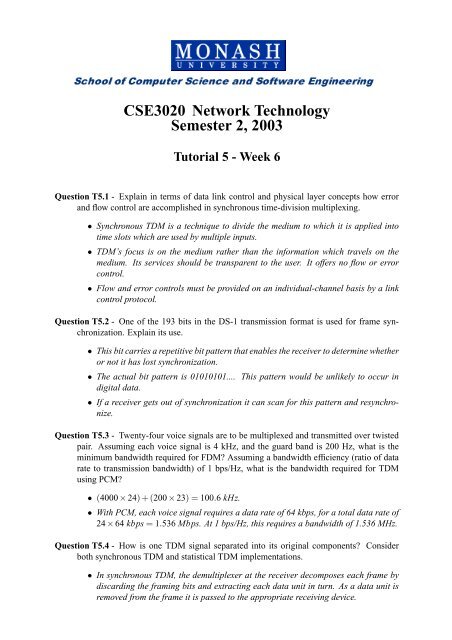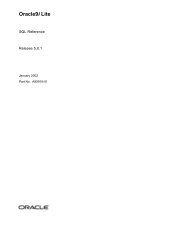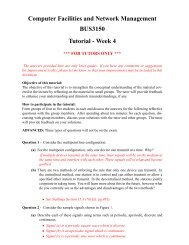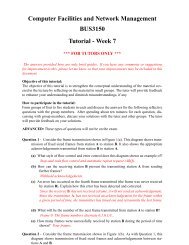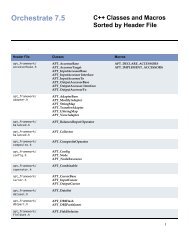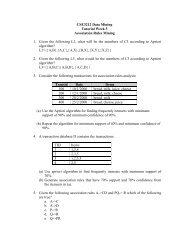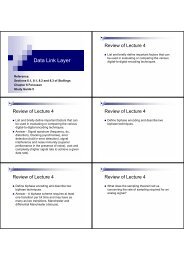CSE3020 Network Technology Semester 2, 2003 - Pravin Shetty ...
CSE3020 Network Technology Semester 2, 2003 - Pravin Shetty ...
CSE3020 Network Technology Semester 2, 2003 - Pravin Shetty ...
Create successful ePaper yourself
Turn your PDF publications into a flip-book with our unique Google optimized e-Paper software.
<strong>CSE3020</strong> <strong>Network</strong> <strong>Technology</strong><br />
<strong>Semester</strong> 2, <strong>2003</strong><br />
Tutorial 5 - Week 6<br />
Question T5.1 - Explain in terms of data link control and physical layer concepts how error<br />
and flow control are accomplished in synchronous time-division multiplexing.<br />
• Synchronous TDM is a technique to divide the medium to which it is applied into<br />
time slots which are used by multiple inputs.<br />
• TDM’s focus is on the medium rather than the information which travels on the<br />
medium. Its services should be transparent to the user. It offers no flow or error<br />
control.<br />
• Flow and error controls must be provided on an individual-channel basis by a link<br />
control protocol.<br />
Question T5.2 - One of the 193 bits in the DS-1 transmission format is used for frame synchronization.<br />
Explain its use.<br />
• This bit carries a repetitive bit pattern that enables the receiver to determine whether<br />
or not it has lost synchronization.<br />
• The actual bit pattern is 01010101.... This pattern would be unlikely to occur in<br />
digital data.<br />
• If a receiver gets out of synchronization it can scan for this pattern and resynchronize.<br />
Question T5.3 - Twenty-four voice signals are to be multiplexed and transmitted over twisted<br />
pair. Assuming each voice signal is 4 kHz, and the guard band is 200 Hz, what is the<br />
minimum bandwidth required for FDM? Assuming a bandwidth efficiency (ratio of data<br />
rate to transmission bandwidth) of 1 bps/Hz, what is the bandwidth required for TDM<br />
using PCM?<br />
• (4000 × 24) + (200 × 23) = 100.6 kHz.<br />
• With PCM, each voice signal requires a data rate of 64 kbps, for a total data rate of<br />
24 × 64 kbps = 1.536 Mbps. At 1 bps/Hz, this requires a bandwidth of 1.536 MHz.<br />
Question T5.4 - How is one TDM signal separated into its original components? Consider<br />
both synchronous TDM and statistical TDM implementations.<br />
• In synchronous TDM, the demultiplexer at the receiver decomposes each frame by<br />
discarding the framing bits and extracting each data unit in turn. As a data unit is<br />
removed from the frame it is passed to the appropriate receiving device.
<strong>CSE3020</strong> <strong>Network</strong> <strong>Technology</strong><br />
<strong>Semester</strong> 2, <strong>2003</strong> Tutorial 5 - Week 6<br />
• In statistical TDM, the demultiplexer at the receiver decomposes each frame by<br />
checking the local address of each data unit. The extracted data unit is removed<br />
from the frame and passed to the appropriate receiving device.<br />
Question T5.5 - Ten 9600-bps lines are to be multiplexed using TDM. Ignoring overhead bits,<br />
what is the total capacity required for synchronous TDM? Assuming that we wish to limit<br />
average line utilization of 0.8, and assuming that each line is busy 50 percent of the time,<br />
what is the capacity required for statistical TDM?<br />
• Synchronous TDM: 9600 bps × 10 = 96 kbps.<br />
• Statistical TDM: 9600 bps × 10 ×<br />
0.8 0.5 = 60 kbps.<br />
Question T5.6 - Briefly describe the basic and primary interface of an Integrated Services Digital<br />
<strong>Network</strong> (ISDN).<br />
From Stallings 6th Edition, page 251-254.<br />
Question T5.7 - ADSL uses FDM to exploit the 1-MHz capacity of twisted pair. Briefly describe<br />
the discrete multitone (DMT) transmission technique used in ADSL.<br />
From Stallings 6th Edition, page 266-267.<br />
• After initialization, the bit stream to be transmitted is divided into a number of substreams,<br />
one for each subchannel that will carry data.<br />
• The sum of the data rates of the substreams is equal to the total data rate.<br />
• Each substream is then converted to an analog signal using QAM.<br />
• Each QAM signal occupies a distinct frequency band, so these signals can be combined<br />
by simple addition to produce the composite signal for transmission.<br />
2


